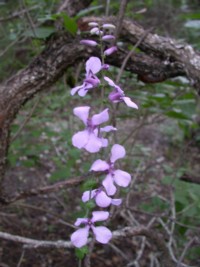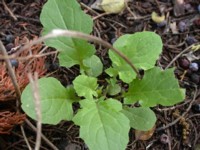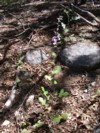
The bracted twistflower
(Streptanthus bracteatus)
Austin's vanishing wildflower
Going, going, ....?

 |
The bracted twistflower
Austin's vanishing wildflower
Going, going, ....? |
 |
Natural history
|
Life cycle: Seeds germinate in the fall. Plants grow as rosettes (see picture at right above) during the winter. They flower in April or May, sending up flowering stalks 1-4 ft tall with 4-petaled flowers. In the summer, the seeds in long pods ripen and then the adult plants die. Seeds can remain dormant in the soil for years. |
|
Habitat: Rocky hillsides and slopes. It is usually found growing under shrubs, but it may not need shade; its present association with shrubs might be because deer have eaten the plants in the open. |
 |
The situation now
|
Why is the bracted twistflower vanishing from Austin?
|
|
|
|